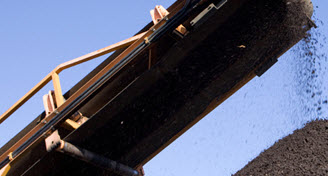Behind the Scenes at the Compost Supplier
Turning Garden Waste into a Healthy Soil Amendment
Copyright © Mack Gill; Kelly Smith All rights reserved; content may not be copied, rewritten, or republished without author’s written permission; Posted July 5, 2012

Commercial composting processes garden waste, recycling anything deemed as “green waste” back into the organic fertilizer used so widely in the garden and in agriculture. There are different methods of composting for different types of waste.
Green waste is composted using a process known as “windrow” — which may only be used on genuine garden waste, i.e. plant matter only.
Stage 1 — Shredding and Hydration
The compost supplier collects garden and green waste and transports to its shredding yard, where the waste is mechanically sorted to ensure there are no contaminants present. Once the green waste has been deemed clean enough to compost, it is passed through a shredder.
Shredding the green waste increases its surface area, which speeds decomposition and it makes the constituent parts of the compost of uniform shape and size.
This means the whole process is easier to manage and the resulting compost is of a predictably fine quality. The compost supplier adds water to the compost if necessary — it needs to maintain a stable water content of 60%.
Stage 2 — Hygienic Temperature Elevation
It is then piled up in windrows ready to begin decomposition. In the first two weeks of composting, a high temperature is maintained to kill off all viruses, pathogenic particles, and seeds.
The heat is naturally generated by the microbes and bacterial organisms breaking the compost down. It is important that the compost supplier keeps the material at 149° F (65° C) for at least seven days in a row.
This is the “magic figure” after which the compost is deemed sanitized — i.e. free from the potential to carry plant diseases or weed seeds.
Stage 3 — Aerobic Managed Composting
Then begins a seven week managed composting phase, in which the core temperature of the windrows must be kept at levels higher than 131° F (55° C). It gets turned at least six times to maintain the aerobic disintegration of the material and to ensure an even spread of decomposition and temperature exposure.
The final two weeks of composting are only entered into after the stabilized compost has been screened to define its future use. Then the maturation phase is entered.
Here the compost is left to stand for two weeks — after which time it is ready to be bagged and used commercially. The compost supplier creates grades suitable for different purposes — from home gardening and allotment use to the fertilization of arable lands and agriculture.
Other Types of Compost
This soil amendment is by no means limited to garden scrap. For example, one high-quality brand is Black Kow® compost (pictured in the video at the top of this article). This particular brand has one component; manure from organically fed milk cows from Texas.
Another specialty type is leaf compost. This type is sometimes left to biodegrade for up to two years and is a very popular lawn top dressing. Regardless of which type you choose for your lawn or vegetable garden, remember that an organic program is based on organic ingredients.
More Organic Gardening and Food Articles
- The Organic Method of Planting a Tree
- Build a Raised Bed Vegetable Garden
- Organic Foliar Feeding with Garrett Juice
- Balanced Soil is the Foundation of Organic Gardening
Website © 2012 Kelly Smith All rights reserved; content may not be copied, rewritten, or republished without author’s written permission; Webmaster’s Google profile